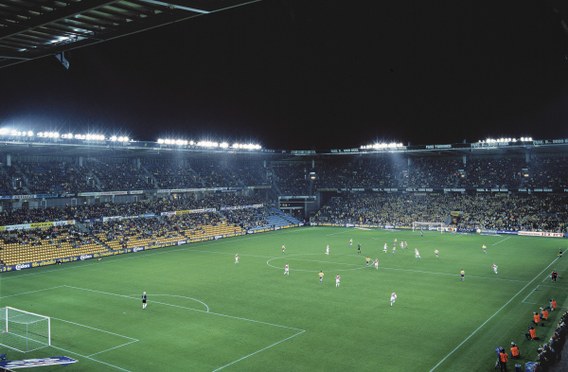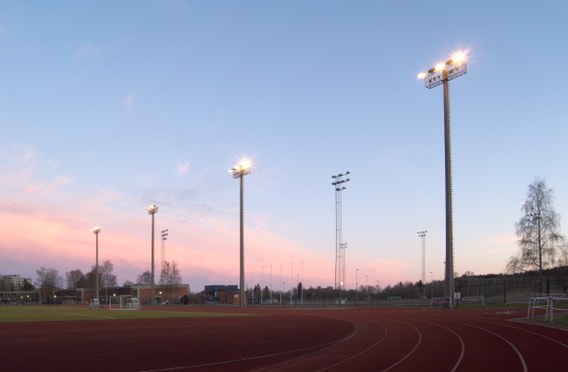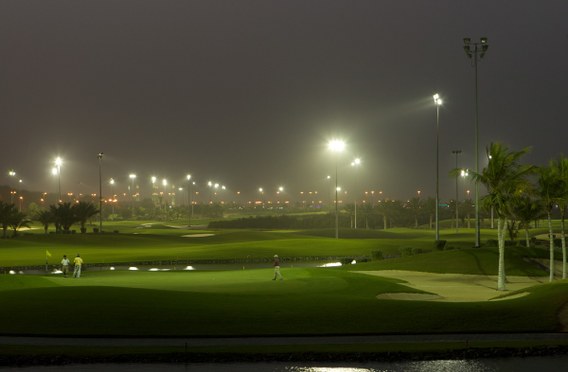Outdoor Sport
Creating the right environment
Sports lighting requires careful consideration of visibility from two differing perspectives, for the competitors the ability to see clearly thus providing a safe arena where they can show off their expertise, and for the spectators, which may include cameras, the ability to see clearly to enjoy the spectacle. So both sets of people need to see clearly but the perspective is different, creating two unique visual scenes and sets of requirements.
Each sport has differing requirements dictated by the speed of play, size of target, size and type of playing area, viewing distance, etc. and individual sports governing bodies will set criteria to account for this. The European Standard EN 12193:2007 Light and Lighting – Sports Lighting gives a good overview of these requirements and the document CIE 169:2005 Practical design guidelines for the lighting of sports events for colour television and filming provides valuable information for televised events in large sporting arenas. In addition for outdoor arenas restricting obtrusive light is essential and the document CIE 150:2003 Guide on the limitation of the effects of obtrusive light from outdoor lighting installations provides valuable design advice. However it should be checked whether the given design limits are valid or if local legislation specifies alternative criteria.
Good colour rendering is essential to differentiate between opposing competitors or teams, and many sports use colour and colour contrast to improve visibility of sports equipment or differentiate different aspects of the playing area or target.
Best practice
For sports involving a fast moving target, especially if the target is also small, care should be taken to ensure there are no stroboscopic effects caused by flicker from the light sources. This can make the target appear to move in a non-continuous manner making play difficult and creating a potential risk to health due to difficulty in visually tracking the target.
Lighting equipment should be chosen after consideration of the environmental conditions. It is necessary to ensure that any fittings are proof against impact considering both force of impact and size of object likely to strike the luminaire. The luminaires should also be appropriate for the local climactic conditions, and should ideally be shaped and mounted to minimise windage, which is the effect of wind producing a stress on the luminaire and all mounting equipment. All stirrups, columns, etc. should be rated to withstand the maximum windage that will be encountered.
Consideration should be given to available luminaire mounting options. The structural design of adjacent spectator areas may place restrictions both in positioning of luminaires and in luminaire weight as some structures have limited weight bearing capabilities. Placement of luminaires should also permit safe and easy access for maintenance. As many sports also place restrictions upon the positioning of luminaires with respect to the playing area to minimise glare and distraction this requires careful design.
Taking control
Lighting controls should allow switching of lighting levels via preset scenes for differing levels of competition, for example training, amateur sports, regional leagues and national or international competition, and also between non-televised and televised events.
When designing lighting for sports facilities it is important to minimise obtrusive and spill light; various strategies may be used depending on the application:
- the use of a high quality optic to control the light helps reduce waste light that falls outside the target area,
- using floodlights that allow the luminaire to be aimed close to the vertical (ie with its face nearly horizontal and pointing downwards) reduces the impact on sky glow. "Flat glass" floodlights are designed to be mounted with their front face horizontal,
- columns with higher mounting heights or positioned closer to the pitch also allow the floodlights to be aimed closer to the vertical; however, structures will be more costly and intrusive during daylight hours.
Lighting controls should allow switching of lighting levels via preset scenes for differing levels of competition, for example training, amateur sports, regional leagues and national or international competition, and also between non-televised and televised events.
Finally sports facilities require safety lighting, designed to allow safe movement of players and spectators in the event of a power failure or emergency. Relevant guidelines from the sports governing bodies should be consulted for this information.
Key products for this application are:
- Champion
- Mundial C
- Troika



